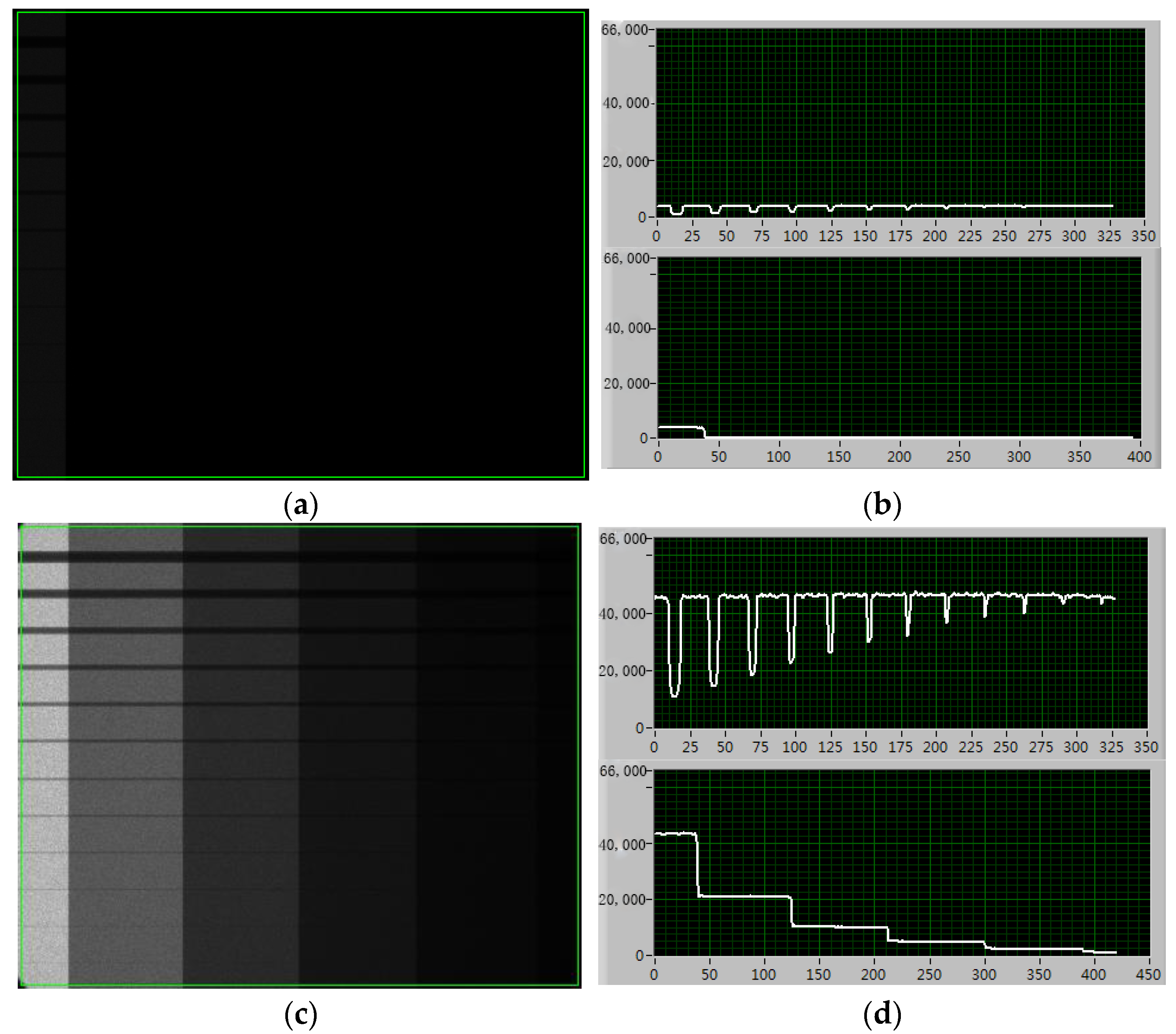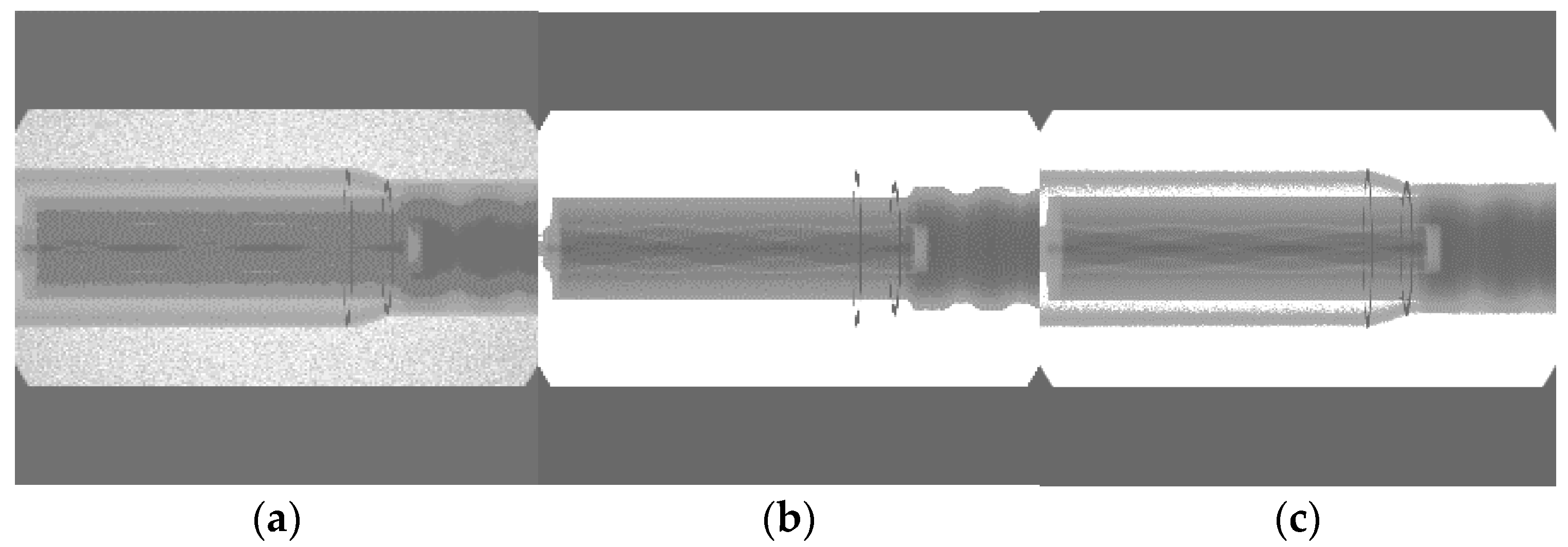Approximation Algorithm for X-ray Imaging Optimization of High-Absorption Ratio Materials
Abstract
:1. Introduction
- At present, the relevant research on X-ray imaging in the industry is mostly the study of a single material, and the X-ray imaging study of the high-absorption ratio material is less, which is more demanding for the selection of the ray source and the subsequent processing of the image;
- Some research results point out that when the ray source selects the appropriate ray energy, X-ray imaging technology can be applied to high-absorption ratio materials but rarely gives a specific ray source selection method;
- In engineering applications, the lack of means to quickly complete the selection of reasonable X-ray sources leads to complicating the subsequent X-ray image enhancement process, which affects the in-depth research of the above technologies.
- Through the X-ray absorption model, combined with the performance of the X-ray imaging detector, with the best symmetry and contrast as the model constraints, decompose the key factors of high absorption ratio material imaging.
- By expanding iterations and simplifying the calculation process, the optimal imaging converging surface is found, and then the optimal energy input conditions of high-absorption materials are obtained and symmetrically balanced.
- Test the effectiveness of the algorithm through experimental simulation and measurement verification. Our method achieves better image quality and reduces subsequent complications of the X-ray image enhancement process.
2. X-ray High Absorption Ratio Structural Imaging Model Optimization
2.1. X-ray Imaging Physical Model Construction
2.2. X-ray High Absorption Ratio Structural Imaging Model Optimization
2.2.1. Model Building
2.2.2. Model Optimization
3. X-ray Image Enhancement Algorithm
3.1. Histogram Equalization Algorithm
- Calculate the cumulative histogram
- Interval conversion of the cumulative histogram
3.2. Bilateral Filtering
4. Experimental Verification
4.1. Step Wedge X-ray Imaging Simulation
4.2. Strain Clamp X-ray Imaging Test
5. Conclusions
Author Contributions
Funding
Institutional Review Board Statement
Informed Consent Statement
Data Availability Statement
Acknowledgments
Conflicts of Interest
References
- Sukovic, P.; Clinthrone, N.H. A method for extending the dynamic range of flat panel imagers for use in cone beam computed tomography. In Proceedings of the 2001 IEEE Nuclear Science Symposium Conference Record (Cat. No.01CH37310), San Diego, CA, USA, 4–10 November 2001. [Google Scholar]
- Kuntz, K.D.; Atz, E.; Collier, M.R.; Collado-Vega, Y.; Connor, H.K.; Porter, F.S.; Sibeck, D.G.; Walsh, B.M. Making the invisible visible: X-ray imaging—ScienceDirect. In Understanding the Space Environment through Global Measurements; Elsevier: Amsterdam, The Netherlands, 2022. [Google Scholar]
- Wilbur, S.; Anastopoulos, C.; AngelMahr, M.; Asfis, G.; Koch, J.; Lindbolm, M.; Lohwasser, K.; Margulis, W.; On Behalf of the FleX-RAY Collaboration. Flexible X-ray imaging detectors using scintillating fibers. J. Instrum. 2022, 17, C10013. [Google Scholar] [CrossRef]
- Li, Y.; Han, Y.; Chen, P. X-Ray Energy Self-Adaption High Dynamic Range (HDR) Imaging Based on Linear Constraints with Variable Energy. IEEE Photonics J. 2018, 10, 3400114. [Google Scholar] [CrossRef]
- Liu, B.; Zhao, P.; Zhao, X.; Zhang, L. Enhancement Algorithm of Variable Energy X-ray Fusion Images. Acta Opt. Sin. 2020, 40, 216–221. [Google Scholar]
- Haidekker, M.; Morrison, L.D.-K.; Sharma, A.; Burke, E. Enhanced dynamic range x-ray imaging. Comput. Biol. Med. 2017, 82, 40–48. [Google Scholar] [CrossRef]
- Cao, F.; Zhao, H. Automatic Lung Segmentation Algorithm on Chest X-ray Images Based on Fusion Variational Auto-Encoder and Three-Terminal Attention Mechanism. Symmetry 2021, 13, 814. [Google Scholar] [CrossRef]
- Zulkifley, M.; Abdani, S.R.; Zulkifley, N.H. COVID-19 Screening Using a Lightweight Convolutional Neural Network with Generative Adversarial Network Data Augmentation. Symmetry 2020, 12, 1530. [Google Scholar] [CrossRef]
- Afifi, A.; Hafsa, N.E.; Ali, M.A.S.; Alhumam, A.; Alsalman, S. An Ensemble of Global and Local-Attention Based Convolutional Neural Networks for COVID-19 Diagnosis on Chest X-ray Images. Symmetry 2021, 13, 113. [Google Scholar] [CrossRef]
- Karlm, A.; Mishra, A. Novel COVID-19 Recognition Framework Based on Conic Functions Classifier. In Healthcare Informatics for Fighting COVID-19 and Future Epidemics; Springer: Berlin/Heidelberg, Germany, 2022; pp. 1–10. [Google Scholar]
- Sniureviciute, M. Problems with film processing in medical X-ray imaging in Lithuania. Radiat. Prot. Dosim. 2005, 114, 260–263. [Google Scholar] [CrossRef]
- Mehranian, A.; Ay, M.R.; Alam, N.R.; Zaidi, H. Quantifying the effect of anode surface roughness on diagnostic X-ray spectra using Monte Carlo simulation. Am. Assoc. Phys. Med. 2010, 37, 742–752. [Google Scholar] [CrossRef] [Green Version]
- Lin, H. The use of the Taguchi method with grey relational analysis and a neural network to optimize a novel GMA welding process. J. Intell. Manuf. 2012, 23, 1671–1680. [Google Scholar] [CrossRef]
- Park, Y.W.; Rhee, S. Process modeling and parameter optimization using neural network and genetic algorithms for aluminum laser welding automation. Int. J. Adv. Manuf. Technol. 2008, 37, 1014–1021. [Google Scholar] [CrossRef]
- Chiang, Y.; Hsieh, H.-H. The use of the Taguchi method with grey relational analysis to optimize the thin-film sputtering process with multiple quality characteristic in color filter manufacturing. Comput. Ind. Eng. 2009, 56, 648–661. [Google Scholar] [CrossRef]
- Sanchez-Gonzalez, A.; Micaelli, P.; Olivier, C.; Barillot, T.R.; Ilchen, M.; Lutman, A.A.; Marinelli, A.; Maxwell, T.; Achner, A.; Agåker, M.; et al. Accurate prediction of X-ray pulse properties from a free-electron laser using machine learning. Nat. Commun. 2017, 8, 15461. [Google Scholar] [CrossRef] [PubMed] [Green Version]
- Ivashchuk, O.O.; Shchagin, A.V.; Kubankin, A.S.; Ionidi, V.Y.; Chepurnov, A.S.; Miroshnik, V.S.; Volkov, V.I.; Lepeshko, D.A. Pyroelectric accelerator and X-ray source in pulsed mode. J. Instrum. 2020, 15, C02002. [Google Scholar] [CrossRef]
- Yang, Y.; Mou, X.; Luo, T.; Tang, S. Reconstruction of X-ray image with super dynamic range by wavelet transform. Acta Photonica Sin. 2009, 38, 2435–2438. [Google Scholar]
- Zhou, J. Study on X-ray Imaging Quality Prediction and Parameter Optimization. Master Thesis, Southeast University, Nanjing, China, 2017. [Google Scholar]
- Zhou, Z.; Li, Y.; Rao, B.; Hu, J.; Mao, R. Application of X-ray imaging technology in quality inspection of tensioning wire clips. Jiangxi Electr. Power 2018, 42, 33–36, 53. [Google Scholar]
- Yuan, J.; Chen, J.; Wang, X. Application of X-ray Imaging technology in the detection of Cable and Accessory defects. China Equip. Eng. 2021, 01, 118–119. [Google Scholar]
- Qiao, Y.; Liu, Y.; Li, Z. Study on the non-uniformity correction method of X-ray imaging system. J. Hebei Acad. Sci. 2021, 38, 1–5, 34. [Google Scholar]
- Chen, L.; Wang, Y. Improved image unevenness reduction and thresholding methods for effective asphalt X-ray CT image segmentation. J. Comput. Civil Eng. 2017, 31, 040170. [Google Scholar] [CrossRef]
- Li, Z.; Wu, Z.; Gao, Y.; Deng, J.; Hu, Z.; Li, L.; Xiao, T.; Fu, Y.; Chen, R. Measurement of Internal geometric Structure and Size of Injector Nozzle Based on Synchrotron radiation High-energy X-ray. J. Jilin Univ. (Eng. Technol. Ed.) 2011, 41, 128–132. [Google Scholar]
- Han, S.; Zhao, K.; Chang, Z. Monitoring Argon L-Shell Auger Decay Using 250-eV Attosecond X-ray Pulses. Sensors 2022, 22, 7513. [Google Scholar] [CrossRef] [PubMed]
- Li, D.; Ni, C.; Gu, M. Application of aluminum filter in Phase-contrast imaging of microfocused tungsten target X-ray source. Opt. Instrum. 2009, 31, 24–27. [Google Scholar]
- Liu, B. Research of High Dynamic Range X-ray Imaging Technology and System. Ph.D. Dissertation, North University of China, Taiyuan, China, 2014. [Google Scholar]
- Ji, A.; Tao, G.; Zhuo, S.; Luo, L. X-ray Fluorescence Spectroscopy, 1st ed.; Science Press: Beijing, China, 2003; pp. 7–9. [Google Scholar]
- Filippov, E.D.; Burdonov, K.F.; Pikuz, T.A.; Skobelev, I.Y. X-ray Self-Emission Imaging of Hydrodynamic Laser-Induced Astrophysical Phenomena. Symmetry 2022, 14, 2536. [Google Scholar] [CrossRef]
- Looker, Q.; Wood, M.G.; Miceli, A.; Niraula, M.; Porter, J.L. Synchrotron characterization of high-Z, current-mode X-ray de-tectors. Rev. Sci. Instrum. 2020, 91, 023509. [Google Scholar] [CrossRef] [PubMed]
- Sun, X.; Zhang, X.; Zhu, Y.; Wang, Y.; Shang, H.; Zhang, F.; Liu, Z.; Sun, T. 13.1 micrometers hard X-ray focusing by a new type monocapillary X-ray optic designed for common laboratory X-ray source. Nuclear Instrum. Methods Phys. Res. A 2018, 888, 13–17. [Google Scholar] [CrossRef]
- Ye, X.; Wu, G.; Huang, L.; Fan, F.; Zhang, Y. Image Enhancement for Inspection of Cable Images Based on Retinex Theory and Fuzzy Enhancement Method in Wavelet Domain. Symmetry 2018, 10, 570. [Google Scholar] [CrossRef] [Green Version]
- Wu, H.; Wu, Z. A Few-Shot Dental Object Detection Method Based on a Priori Knowledge Transfer. Symmetry 2022, 14, 1129. [Google Scholar] [CrossRef]
- Karim, A.M.; Kaya, H.; Alcan, V.; Sen, B.; Hadimlioglu, I.A. New Optimized Deep Learning Application for COVID-19 Detection in Chest X-ray Images. Symmetry 2022, 14, 1003. [Google Scholar] [CrossRef]
- Berinde, V.; Ţicală, C. Enhancing Ant-Based Algorithms for Medical Image Edge Detection by Admissible Perturbations of Demicontractive Mappings. Symmetry 2021, 13, 885. [Google Scholar] [CrossRef]
- Li, Y. Research on Key Technologies of Portable Low-intensity X-ray Real-Time Imaging System. Ph.D. Dissertation, Changchun University of Science and Technology, Changchun, China, 2011. [Google Scholar]
- Li, W. Research on Low-Dose Dual-Energy X-ray Item Inspection and Liquid Dangerous Goods Identification Technology. Master Thesis, Northeastern University, Qinhuangdao, China, 2010. [Google Scholar]
- Raza, H.S.; Kim, H.J.; Ha, J.M.; Cho, S.O. Behavior of characteristic X-rays from a partial-transmission-type X-ray target. Appl. Radiat. Isotopes 2013, 80, 67–72. [Google Scholar] [CrossRef]
- Xu, C.; Zhang, X.; Chen, Y.; Li, M.; Park, J.-S.; Kenesei, P.; Almer, J.; Yang, Y. In-situ high energy X-ray characterization of neutron irradiated HT-UPS stainless steel under tensile deformation. Acta Mater. 2018, 156, 330–341. [Google Scholar] [CrossRef]
- Liu, Y. Research on Influencing Factors of X-ray Imaging and Image Processing Technology. Master Thesis, Changchun University of Science and Technology, Changchun, China, 2014. [Google Scholar]
- Nishimura, R.; Arai, Y.; Miyoshi, T.; Hirano, K.; Kishimoto, S.; Hashimoto, R. Development of an X-ray imaging system with SOI pixel detectors. Nuclear Instrum. Methods Phys. Res. Sect. A 2016, 831, 49–54. [Google Scholar] [CrossRef]










| SIT. 1 | SIT. 2 | SIT. 3 | SIT. 4 | SIT. 5 | |
|---|---|---|---|---|---|
| Calculate (kV) | 101 | 139 | 170 | 163 | 182 |
| Measured (kV) | 106 | 145 | 167 | 165 | 177 |
| Error Rate | 4.7% | 4.1% | 1.8% | 1.2% | 2.7% |
Disclaimer/Publisher’s Note: The statements, opinions and data contained in all publications are solely those of the individual author(s) and contributor(s) and not of MDPI and/or the editor(s). MDPI and/or the editor(s) disclaim responsibility for any injury to people or property resulting from any ideas, methods, instructions or products referred to in the content. |
© 2022 by the authors. Licensee MDPI, Basel, Switzerland. This article is an open access article distributed under the terms and conditions of the Creative Commons Attribution (CC BY) license (https://creativecommons.org/licenses/by/4.0/).
Share and Cite
Liu, Y.; Li, Y.; Jiang, S.; Ye, X.; Liu, G. Approximation Algorithm for X-ray Imaging Optimization of High-Absorption Ratio Materials. Symmetry 2023, 15, 44. https://doi.org/10.3390/sym15010044
Liu Y, Li Y, Jiang S, Ye X, Liu G. Approximation Algorithm for X-ray Imaging Optimization of High-Absorption Ratio Materials. Symmetry. 2023; 15(1):44. https://doi.org/10.3390/sym15010044
Chicago/Turabian StyleLiu, Yanxiu, Ye Li, Sheng Jiang, Xin Ye, and Guoyi Liu. 2023. "Approximation Algorithm for X-ray Imaging Optimization of High-Absorption Ratio Materials" Symmetry 15, no. 1: 44. https://doi.org/10.3390/sym15010044






